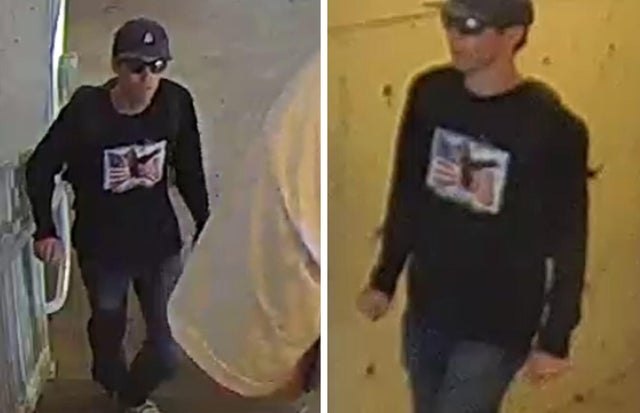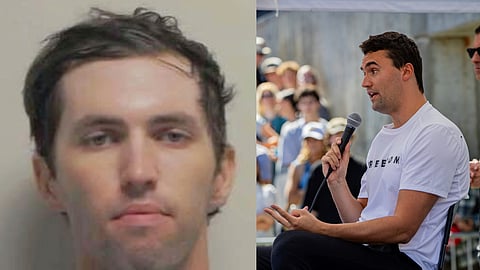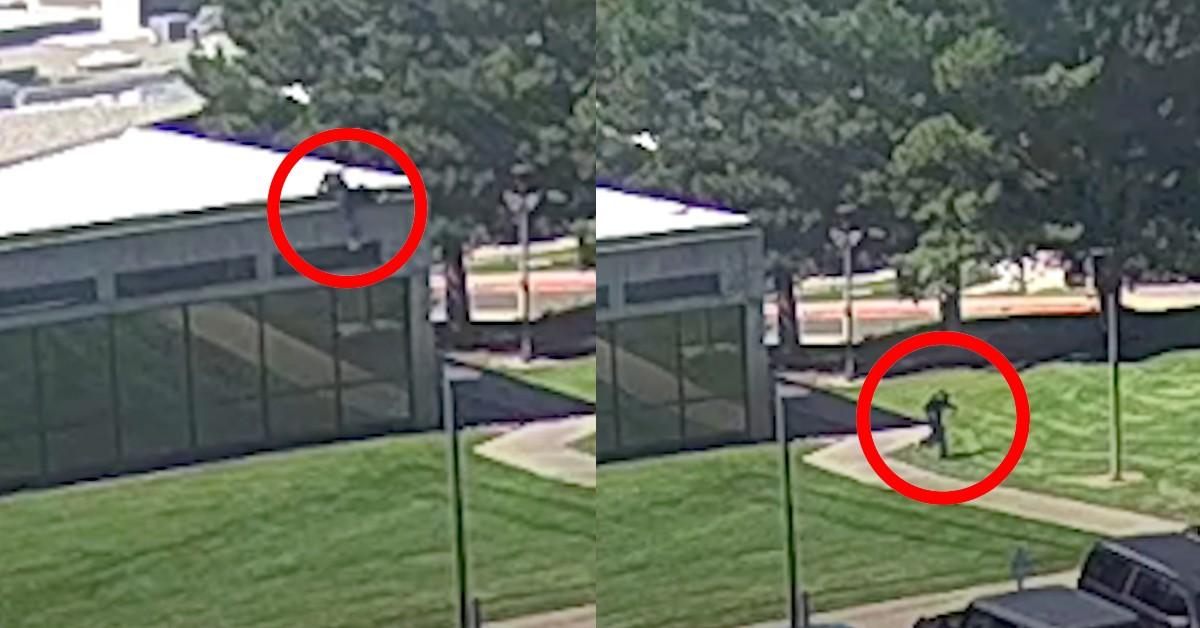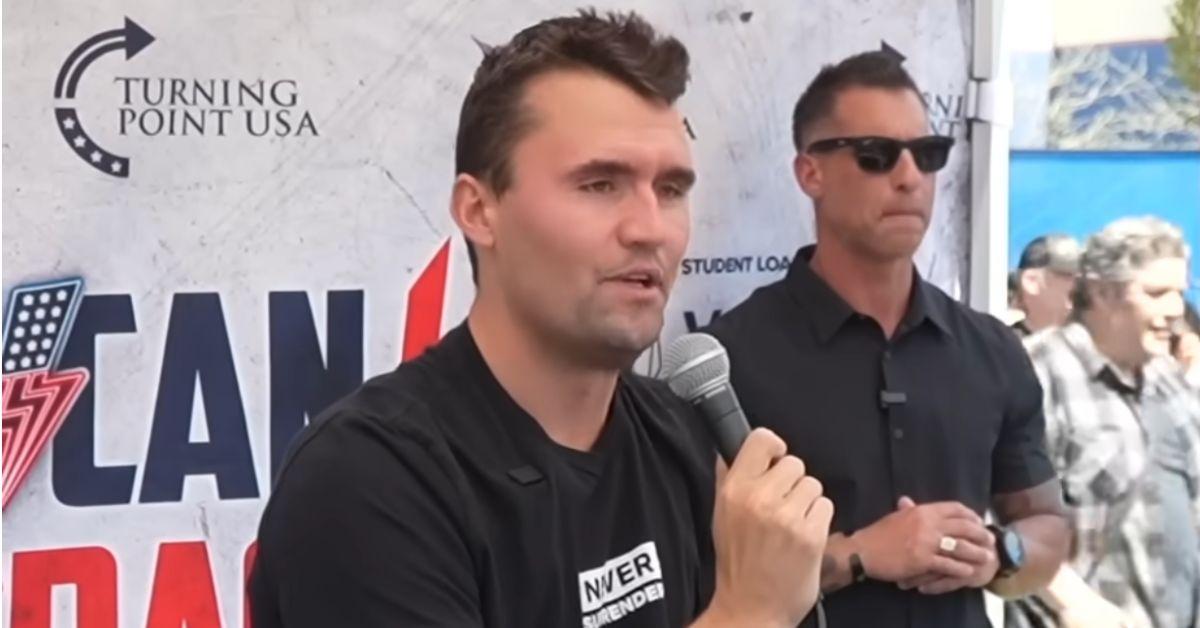The man behind Charlie Kirk’s camera just captured something that changes everything — and the SD card, which someone once tried to erase, has suddenly resurfaced, revealing a clue that might have been overlooked all along.
The man behind Charlie Kirk’s camera just captured something that changes everything — and the SD card, which someone once tried to erase, has suddenly resurfaced, revealing a clue that might have been overlooked all along.
It started with a single frame — a still image no one thought twice about.
But in that frozen second, something was captured that no one noticed until now.
And it’s that overlooked moment that might reshape everything we thought we knew about the Charlie Kirk case.
When news first broke of the tragic event, the world watched in disbelief. The headlines arrived within minutes. Social media erupted with theories, timelines, and endless debates. But as the story evolved, one person’s name quietly began to surface —
At first, he was simply known as the videographer assigned to document the event, a familiar face at dozens of public gatherings. He wasn’t famous, wasn’t controversial, and didn’t seek attention. Yet today, his footage — and one small SD card — has become the most talked-about mystery in the ongoing investigation.

The Forgotten Cameraman
The cameraman, whose identity remains largely private, was reportedly one of the last people near the scene before chaos unfolded. He stood quietly, focused, recording everything with a steady hand — unaware that his footage might one day become the center of a nationwide discussion.
In the initial confusion, authorities gathered every piece of visual evidence they could find. Dozens of clips, hundreds of photographs, and hours of live-streamed video were compiled, reviewed, and cataloged. Yet according to several reports circulating online, one specific SD card — the one belonging to Kirk’s official cameraman — was missing for weeks.
It was presumed erased, misplaced, or simply irrelevant.
But recently, something changed.
A backup copy surfaced — and the footage inside has reignited questions no one expected to ask again.

The Moment That Everyone Missed
When analyzed frame by frame, the cameraman’s video reveals a timeline slightly different from what was previously understood. Nothing extreme. Nothing obviously shocking. But subtle inconsistencies — timing differences, background movement, shadows shifting at impossible angles — have led analysts to revisit key moments.
In one brief shot, the cameraman appears to pan toward a section of the crowd where something flickers — a motion or reflection that doesn’t seem to align with other footage. For months, that fraction of a second went unnoticed. But now, digital analysts and forensic editors claim it may hold hidden importance.
Could it simply be a trick of light? Or something more?
The questions have reopened debates about how that day truly unfolded.
Why the SD Card Matters
Digital media experts emphasize that raw footage often preserves details overlooked in edited clips. Every frame contains time codes, lighting shifts, and environmental sounds that together tell a precise story. According to multiple independent analysts, those metadata details could reveal the
The resurfaced SD card, according to one source familiar with its contents, may include several seconds that were not seen in previous public versions of the video.
Seconds that, if verified, could challenge certain assumptions made early in the investigation.
Nothing illegal, nothing conclusive — but enough to warrant a closer look.
And that’s exactly what has happened.
Within hours of the footage being quietly shared among investigators and journalists, conversations reignited across social media platforms. Has a crucial clue been hiding in plain sight all this time? Or are these merely coincidences amplified by a public desperate for clarity?

The Public Reaction
Online, the response has been swift and intense. Comment sections flooded with messages ranging from skepticism to renewed hope that the truth will finally emerge. Hashtags trended overnight. Clips claiming to show portions of the recovered footage spread rapidly, even as official sources refused to comment on their authenticity.
For many, the mystery has reopened deep questions about transparency, trust, and how stories are told in the digital age.
One viral post read: “We were told everything had been reviewed. So how does a missing SD card suddenly appear?”
Another user replied: “If there’s nothing to hide, why was this footage buried?”
Neither question can be easily dismissed. And that, perhaps, is what makes this new development so powerful — it doesn’t accuse, it doesn’t assume; it simply asks,
Behind Closed Doors
According to individuals close to the media production team, the original recording equipment was turned over immediately after the incident, as required by investigators. The process was routine — standard evidence collection, nothing more. But in large investigations, items can be copied, archived, and stored in multiple places, sometimes with incomplete documentation.
In this case, that appears to have happened.
Weeks later, during an unrelated equipment audit, a technician reportedly discovered a secondary memory card stored under a different label. It contained backup footage recorded simultaneously from the same event.
That’s when the whispers began.
What exactly did this newly found SD card show?
And why wasn’t it catalogued earlier?
While official statements have not confirmed or denied these details, the timing has fueled speculation that something may have been overlooked in the rush to finalize the early findings.
A New Wave of Independent Analysis
Digital forensics teams, amateur analysts, and even video hobbyists have begun their own reviews of what they believe to be authentic fragments of the recovered footage. Their findings vary widely. Some claim to see nothing unusual at all. Others point to small, almost imperceptible details — the direction of a person’s glance, a sudden camera shake, or a background sound inconsistent with the scene.
The most fascinating part of this renewed analysis isn’t necessarily what’s in the footage, but the fact that people are looking again.
It has reignited a culture of curiosity, skepticism, and demand for accountability.
Everyone seems to agree on one point:
The cameraman’s footage has become a mirror — reflecting both the story itself and the public’s deep desire to understand it.
Inside the Camera Lens
To understand why this video matters, one must appreciate what it represents: perspective.
A camera doesn’t interpret; it captures.
But the way footage is framed — the angle, timing, and context — can change meaning entirely.
For months, the world has only seen fragments: a few official clips, select stills, and edited highlights released for clarity. But unfiltered, continuous footage offers something no report can replace — context. It shows not only what happened, but how people reacted, who moved where, and in what sequence.
And that is precisely what makes this SD card so intriguing.
If verified as authentic, it may reveal the rhythm of those crucial moments — not just the facts, but the feeling.
The Human Element
Lost in all the technical talk about data recovery and timestamps is a simple human truth: behind every camera stands a person. The cameraman, who reportedly stayed quiet for months, is said to have been deeply affected by what he witnessed that day.
Friends describe him as meticulous, private, and haunted by the idea that something he filmed might hold unanswered questions.
In recent weeks, unconfirmed reports suggest he has spoken with investigators once more, providing context for the recovered footage.
“He never wanted to be part of the story,” one acquaintance shared. “But maybe the story found him.”
The Larger Picture
What makes this revelation so compelling isn’t just the footage itself — it’s what it symbolizes. In an age when digital truth can be edited, filtered, and reshaped within seconds, the rediscovery of raw, unaltered footage feels like a return to authenticity.
It represents a second look — a chance to revisit assumptions, to see through the noise, and to let evidence, not emotion, guide the narrative.
The Charlie Kirk case has been the subject of countless reports, interviews, and online debates. Every time the public thinks it understands what happened, a new layer seems to emerge.
Now, with the resurfaced SD card, another chapter begins.
Questions That Still Remain
Was this backup footage genuinely lost — or was it simply overlooked in the early stages?
If it was overlooked, why?
And if not, what might explain the differences analysts are now discussing?
Even more curiously, how did the backup reappear now, after months of silence?
Every possible answer opens another door of speculation.
Experts caution the public against drawing conclusions too quickly.
“Missing footage doesn’t automatically mean manipulation,” one media analyst told The Sentinel Review. “Sometimes, it’s just the chaos of evidence management. But other times, yes — something small can change how we see the entire story.”
The Role of the Media
The media’s handling of the event has been a central topic since the beginning. With information moving faster than ever, clarity often struggles to keep up. Reporters race deadlines; narratives solidify before all details are known. The discovery of new evidence — however small — challenges those early assumptions and forces a re-evaluation of coverage.
In the days following the resurfacing of the footage, several outlets have quietly adjusted their previous reports. Not because they were necessarily wrong, but because new information demands new context.
And context, in this case, is everything.
The Power of One Frame
The idea that a single camera frame — one sixtieth of a second — could shift public understanding may sound dramatic. But history is full of such moments.
One extra angle, one hidden reflection, one overlooked sound can transform an entire investigation.
It’s not about proving anyone right or wrong.
It’s about seeing clearly.
If the cameraman’s footage ultimately confirms existing findings, it will restore confidence in the process. If it challenges them, it will demand accountability.
Either outcome serves truth — and that’s the point.
Why People Can’t Look Away
Perhaps the greatest reason the story resonates is because it reflects something larger than one event.
It’s about how people today search for meaning in chaos — how we all want to believe that truth, however complicated, will eventually surface.
The cameraman’s SD card is more than a piece of plastic with data on it.
It’s a symbol — of transparency, of perseverance, and of a collective refusal to accept uncertainty forever.
When viewers watch the recovered footage, they’re not just analyzing pixels. They’re searching for closure.
What Happens Next
As of now, the recovered SD card is reportedly being examined by digital forensics specialists. Officials have made no public statement regarding its findings. But in an era of online leaks and viral speculation, it’s unlikely that the public will stop talking about it anytime soon.
Independent researchers continue to post side-by-side video comparisons, while journalists press for an official update. Whether those answers come tomorrow or months from now, one thing is clear — the public’s appetite for truth has only grown stronger.
The story has transcended the event itself; it has become a test of faith in information.
A Story Still Unfolding
No one can say for certain what the final outcome will be. Maybe the newly surfaced footage changes nothing.
Or maybe it changes everything.
What’s certain is that a camera once forgotten — a lens that silently recorded the truth as it happened — has now become the focus of the entire discussion.
The world is watching again.
The footage is rolling once more.
And this time, every frame matters.
New Viral Clip: Millions Are Rewatching the 12-Second Moment Everyone Can’t Look Away From — Candace Owens Says, ‘Everything We Thought Was Wrong’ — Experts Stunned by the Viral Footage.

It started quietly — a short, low-resolution video uploaded to a barely-followed account late one evening.
No caption, no context, just a 12-second clip.
Within hours, it exploded across every corner of the internet.
TikTok. X. Reddit. Telegram.
By morning, millions had seen it — and no one could agree on what they were actually watching.
Candace Owens, one of the most influential voices online, called it “the moment that rewrites everything.”
Her exact words:
“Everything we thought was wrong.”
And just like that, the clip transformed from a passing curiosity into a full-blown cultural event.

🎥 The Clip That Captivated the Internet
The footage is short but unforgettable.
It begins with a blurred crowd in motion — laughter, voices, and faint background noise. Then, the camera shifts. A man, believed to be Charlie Kirk, appears in frame for just a few seconds before collapsing suddenly, his movement caught only partially on screen.
But that isn’t what sent the internet into chaos.
It’s what happens in the background.
A faint shadow, a movement behind him, something indistinct yet strangely deliberate — seen only if you pause at exactly the right moment.
For days, users replayed the clip frame by frame, zooming in, adjusting contrast, slowing it down.
And then came the question that ignited the storm:
“If this clip is real… what have we been missing all along?”
💥 Candace Owens Reacts: “Everything We Thought Was Wrong”
Candace Owens has never been one to shy away from controversy — but this time, her words carried an edge of disbelief even she couldn’t hide.
In a late-night livestream viewed over 2 million times in less than a day, Owens broke down the footage with forensic precision.
She paused at key frames, zoomed in on the background, and asked her viewers to “look again.”
“Watch the left corner,” she said. “See that? It’s not light. It’s movement. Something’s there — and no one noticed until now.”
Her statement — “Everything we thought was wrong” — became the most repeated phrase of the weekend.
Within hours, hashtags like #12SecondTruth, #HiddenFrame, and #CandaceClip trended worldwide.

🔍 Experts Step In — “We Can’t Explain What We’re Seeing”
Digital analysts and video forensics experts soon entered the conversation.
Some were intrigued. Others were skeptical.
Dr. Hannah McBride, a professor of media analysis at Stanford, told a morning news outlet:
“It’s not about what’s in the video — it’s about how people are interpreting it. The human brain is wired to fill in missing details, especially in unclear or emotional footage.”
Still, even she admitted that the clip’s timing raised questions.
The metadata revealed that the file was created two days earlier than previously known recordings.
That discrepancy, though minor, opened the door to endless speculation about who filmed it, why it was hidden, and how it suddenly resurfaced now.
📱 The Internet Loses Control
By Friday afternoon, the clip had been shared more than 48 million times.
Comment sections flooded with disbelief, confusion, and heated debates.
On TikTok, users began uploading slowed-down versions, claiming to uncover hidden movements, reflections, and even whispers.
On Reddit, massive threads formed around theories about the “missing frames” and what they might imply.
One viral comment summed up the public’s obsession:
“It’s only 12 seconds — but it feels like a lifetime of unanswered questions.”
Memes appeared. Edits were made. Podcasts devoted entire episodes to breaking it down second by second.
And through it all, Candace Owens continued to post cryptic updates:
“Don’t stop watching. Don’t let them bury this clip.”
📡 The Power of a Single Frame
Why do people care so much about a few blurry seconds?
Psychologists say it’s because the clip hits the perfect balance of clarity and confusion — enough detail to spark belief, but enough mystery to demand answers.
Dr. Leo Grayson, a behavioral analyst, explained it best:
“When people encounter ambiguity tied to emotion or tragedy, their brains crave closure. They replay, rewatch, and theorize until the uncertainty feels resolved.”
That craving — multiplied by millions of viewers — transformed a simple clip into a digital obsession.
🧩 The Timeline Problem
As more analysts examined the footage, one question became impossible to ignore:
When exactly was this video recorded?
According to metadata shared by a tech account on X, the file’s timestamp doesn’t match the timeline of previously confirmed footage from the same event.
That led to a surge of speculation — could the viral clip have been withheld, altered, or recorded by someone who never intended it to be seen?
Even mainstream outlets began covering the controversy, describing it as “a digital puzzle testing the limits of online truth.”
🎙️ Candace Owens Doubles Down: “We’re Being Shown Only What They Want Us to See”
During her second broadcast, Owens addressed her critics directly.
Her voice was steady, her tone unwavering.
“I’m not here to assign blame,” she said. “I’m here to ask why. Why was this clip hidden? Why was it edited out of every official report? Why now?”
She ended her stream with a promise:
“More videos are coming. And when they do, people will realize how much has been kept from them.”
The moment she said it, the internet erupted again.
🧠 Experts Try to Calm the Storm — “Correlation Isn’t Conspiracy”
As the story spun out of control, digital forensics teams urged caution.
Fact-checking organizations confirmed they were analyzing the footage but warned the public not to jump to conclusions.
“Videos like this can easily be taken out of context,” one expert noted. “Until the original file is authenticated, we’re dealing with speculation, not evidence.”
But by that point, the genie was out of the bottle.
Millions had already formed opinions — and no official clarification seemed capable of slowing the momentum.
📂 Leaks, Links, and “Unedited Versions”
Soon after, claims of an “unedited version” began circulating online.
Private group chats and encrypted channels were said to be sharing a longer, higher-quality recording — one that allegedly contained the missing context.
None of these claims have been verified.
Still, their existence added another layer to the mystery, fueling theories that the viral clip was only part of a larger story.
The more people searched, the more questions surfaced.
“Who was holding the camera?”
“Why was the video cut off at exactly 12 seconds?”
“And how did Candace Owens get it first?”
🕵️♂️ Investigators Step Forward
After days of speculation, a spokesperson confirmed that the video is under review.
No details were given, only that “all relevant footage” related to the event is being reexamined.
That announcement — brief as it was — reignited interest all over again.
If officials were looking into it, people reasoned, then something must be there.
Even skeptics began to reconsider.
💬 Public Reaction: Divided Yet United in Curiosity
Across platforms, one thing is clear: everyone’s watching.
Some see the viral clip as evidence of a hidden truth.
Others dismiss it as a distraction or a manipulated upload designed to provoke chaos.
But almost no one can stop talking about it.
“It’s like a modern-day Zapruder film,” wrote one media columnist, referencing the famous footage from decades past.
“Everyone’s seeing the same 12 seconds, but everyone’s seeing something different.”
⚡ The 12 Seconds That Changed the Conversation
Every major cultural moment has a turning point — a piece of media that redefines what people believe they know.
For millions, this 12-second video has become exactly that.
It doesn’t matter whether it’s real, staged, or misunderstood.
What matters is how it made people feel — curious, uneasy, and hungry for the truth.
And in today’s world, emotion spreads faster than fact.
🧭 Candace Owens’ Closing Words: “This Is Just the Beginning”
In her latest post, Owens wrote:
“We’re not just talking about a clip. We’re talking about a pattern — a pattern of silence, timing, and selective truth. People are waking up.”
Her statement has since been quoted thousands of times, shared across every major social network.
Whether she’s right or wrong, one thing is undeniable: Candace Owens knows how to hold the world’s attention.
🌎 Beyond the Screen — The Cultural Ripple Effect
Sociologists are now studying how this viral phenomenon mirrors a larger trend: distrust of official narratives and the rise of “participatory truth.”
People no longer wait for journalists or investigators to tell them what’s real.
They crowdsource, analyze, and decide for themselves.
The “12-Second Clip” has become a symbol of that shift — a digital mirror reflecting society’s uneasy relationship with information itself.
🔄 The Endless Replay
Even now, days later, the clip continues to circulate.
New edits emerge every hour. Some slow it to one frame per second. Others enhance brightness, isolate sounds, or overlay commentary.
Each version brings new interpretations — and new arguments.
Yet no one can provide definitive proof of what really happened in those few fleeting seconds.
And perhaps that’s why it refuses to fade away.
🕰️ When Time Freezes in 12 Seconds
In the end, this story isn’t about a video — it’s about perception.
It’s about how one short moment can suspend reality, divide audiences, and redefine memory.
Candace Owens’ reaction — shocked, passionate, relentless — captured the public mood perfectly: a mix of disbelief and determination.
And as the investigation continues, one truth remains:
the more people try to understand those 12 seconds, the less certain the world seems to become.
✒️ Final Thoughts: What the Viral Moment Really Means
The “12-Second Clip” has become more than a headline — it’s a case study in how digital culture works.
It proves that emotion can override evidence, that mystery can outpace fact, and that once something hits the internet, it can never truly be erased.
Candace Owens may have been right in one sense — not about the footage itself, but about what it reveals:
that everything we thought was certain in the age of social media can change in an instant.
Twelve seconds.
One clip.
And a world still arguing over what it just saw.





